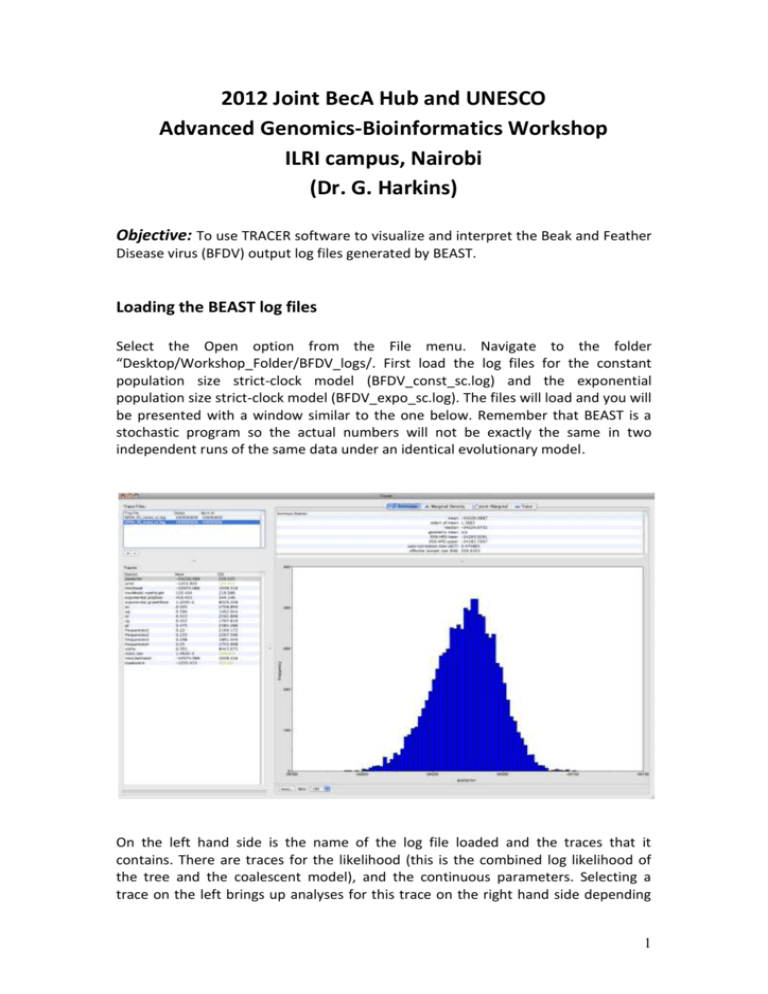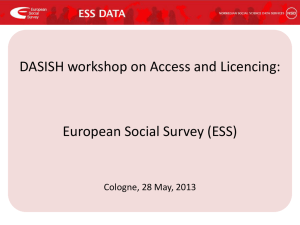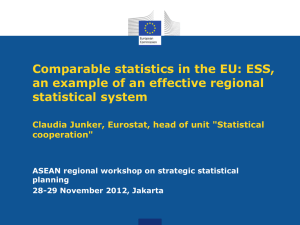Kenya_handout_part2
advertisement

2012 Joint BecA Hub and UNESCO Advanced Genomics-Bioinformatics Workshop ILRI campus, Nairobi (Dr. G. Harkins) Objective: To use TRACER software to visualize and interpret the Beak and Feather Disease virus (BFDV) output log files generated by BEAST. Loading the BEAST log files Select the Open option from the File menu. Navigate to the folder “Desktop/Workshop_Folder/BFDV_logs/. First load the log files for the constant population size strict-clock model (BFDV_const_sc.log) and the exponential population size strict-clock model (BFDV_expo_sc.log). The files will load and you will be presented with a window similar to the one below. Remember that BEAST is a stochastic program so the actual numbers will not be exactly the same in two independent runs of the same data under an identical evolutionary model. On the left hand side is the name of the log file loaded and the traces that it contains. There are traces for the likelihood (this is the combined log likelihood of the tree and the coalescent model), and the continuous parameters. Selecting a trace on the left brings up analyses for this trace on the right hand side depending 1 on tab that is selected. In the picture above, the log likelihood trace is selected for the exponential strict-clock model and various statistics of these traces are shown under the Estimates tab. Note that the Effective Sample Sizes (ESS) values for all the traces are large (ESS values less than 200 are highlighted in gold by Tracer). This is good. A high ESS value means that the trace contained relatively few correlated samples and thus is a good representation the posterior distribution. In the bottom right of the window is a frequency plot of the samples, which as expected given the high ESS values, are quite smooth. We can improve these ESS values by setting the burn-in for the constant model at 5 million steps and the exponential model at 1 million steps. Highlight both models and click on the tab labelled marginal density. 2 The statistics and their meaning are described below. Mean The mean value of the sampled trace across the chain (excluding the burnin). Stdev 3 The standard deviation of the mean. This takes into account the effective sample size so a small ESS will give a large Stdev. Median The median value of the sampled trace across the chain (excluding the burnin). 95% HPD Lower The lower bound of the highest posterior density (HPD) interval. The HPD is a credible set that contains 95% of the sampled values. 95% HPD Upper The upper bound of the highest posterior density (HPD) interval. The HPD is a credible set that contains 95% of the sampled values. Auto-Correlation Time (ACT) The number of states in the MCMC chain that two samples have to be from each other for them to be uncorrelated. The ACT is estimated from the samples in the trace (excluding the burn-in). Effective Sample Size (ESS) The ESS is the number of independent samples that the trace is equivalent to. This is essentially the chain length (excluding the burn-in) divided by the ACT. If we select the Trace we can view the raw trace, that is, the sampled values against the step in the MCMC chain: This is what we are aiming for - we call this plot the hairy caterpillar. There are no obvious trends in the plot suggesting that the MCMC was still converging and there are no large-scale fluctuations in the trace suggesting poor mixing. 4 As we are happy with the behaviour of log-likelihood, we can now move on to one of the other parameters of interest: the mutation rate. Select siteModel.mu in the lefthand table. This is the mutation rate averaged over all three codon positions. Choose the tab labelled Estimates to view a comparison of the estimates of the posterior probability density of this parameter between models. You should see a graph similar to this one showing the mean and the associated 95% HPD intervals for this parameter. View the density plot by selecting the tab labeled Marginal Density to see a plot of these estimates. 5 As you can see the marginal posterior probability density is a reasonable looking bell-shaped curve under both models. There is some stochastic noise that would be reduced if we ran the chain for longer, but we already have a pretty good estimate of the mean and credible interval for the mutation rate parameter under each model. 6 Bayes Factor Testing 7 A value for the log10 Bayes factor > 3 indicates that one of the models has significantly greater support that the other. In this case (BF = 1.47), therefore neither 8 model is a better fit to the data. i.e. under a strict-clock model we cannot discriminate between a constant and exponentially growing population with this data. Given that we cannot discriminate between the different demographic models of population size we can now focus on comparing across different clock models (strict vs. relaxed). Close the exponential strict-clock log file and open the constant population size relaxed-clock log file (BFDV_const_rc.log) located in the folder labelled BFDV_logs. Notice that unlike the constant population size strict clock model, the relaxed clock ESS values for several of the traces are small (ESS values less than 200 and 100 are highlighted in gold and red respectively by Tracer). This is not good. A low ESS value means that the trace contained many correlated samples and thus is a not good representation the posterior distribution. Comparing the traces for the log likelihood parameter between the strict and relaxed-clock models explains why such low ESS values were obtained. 9 Now compare the log likelihoods by clicking on the tab labelled Estimates 10 Bayes Factor Testing In this case a BF of 194.962 indicates that the relaxed-clock nucleotide substitution is a much better fit to the data than the strict-clock model assuming a constant population size. 11 So far we have established that a) under a strict-clock model we cannot discriminate between the constant and exponential demographic models and b) under a constant population size model the relaxed-clock model provides a significantly better fit to the data than the strict-clock model. Finally we can compare whether either demographical model provides a better fit under the relaxed-clock model. Close the constant strict clock log file and open the exponential relaxed clock log file located in the folder xxx. Notice that again the ESS values for many of the traces under the relaxed-clock model are very small indeed. However, further examination of the trace file for these parameters provides the cause of such low values. Examining the log likelihood trace for the exponential growth model it becomes clear that the low ESS values are caused by application of an inappropriately sized burn-in period. 12 If we correct for this by applying a burn-in value of 40 million steps to the exponential relaxed-clock model the ESS values improve significantly but many remain too small to represent the posterior distribution well. Essentially, this simply looks as if we need to run the chain for longer. Given the lowest ESS (for the coalescent likelihood) is 25.88, it would suggest that we have to run it for ~8 times longer to get ESS values that are > 200. 13 If we ignore for the moment the small ESS values for these models and again compare their fit to the data using Bayes factor testing we can see that a BF of 0.432 indicates that neither of the demographic models provides a better fit to the data under a relaxed-clock model and therefore the results under both models should be presented (Supplementary material). In practice, we should rerun the Markov chain for much longer for all of the models with ESS values of <200 for any of the traces and only then, compare using Bayes factors or other tests. 14








